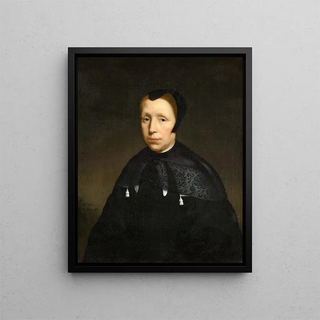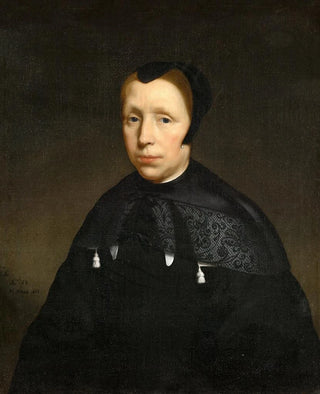Art print | Portrait of a Widow - Nicolaes Maes


View from behind

Frame (optional)
The "Portrait of a Widow" by Nicolaes Maes is a work that transcends mere portraiture to capture the essence of a profound emotion. Created in the 17th century, this painting embodies not only the technical virtuosity of the artist but also offers a penetrating insight into the human condition. The widow, the central figure of this composition, seems to tell us a story through her melancholic expression and distant gaze. The piece invites us to delve into a universe where the past and present intertwine, where every detail carries meaning and emotion.
Style and uniqueness of the work
Nicolaes Maes's style is distinguished by its striking realism and meticulous attention to detail. In "Portrait of a Widow," light plays a fundamental role, illuminating the protagonist's face while creating delicate shadows that add depth to the scene. The textures of the clothing, carefully rendered, testify to exceptional craftsmanship, while the choice of colors, both dark and luminous, evokes a nostalgic atmosphere. The composition is carefully balanced, with each element arranged to guide the viewer's eye toward the widow's face, a true window into her soul. This portrait is not limited to a simple representation; it becomes a mirror of complex feelings, oscillating between sadness and dignity.
The artist and his influence
Nicolaes Maes, a pupil of Rembrandt, established himself as one of the masters of 17th-century Dutch painting. His work is marked by a unique ability to capture the intimacy of his subjects. Influenced by his mentor's techniques, Maes developed a distinctive style, combining psychological depth with impeccable technical execution. His portraits, both personal and universal, explore themes such as solitude, reflection, and memory. Through his paintings, he leaves an indelible mark on art history, inspiring generations of artists to explore the richness of human emotions. The "Portrait of a Widow" is an emblematic example of this quest for inner truth, where every gaze, every gesture, tells a story.
An exceptional wall decoration

Matte finish

View from behind

Frame (optional)
The "Portrait of a Widow" by Nicolaes Maes is a work that transcends mere portraiture to capture the essence of a profound emotion. Created in the 17th century, this painting embodies not only the technical virtuosity of the artist but also offers a penetrating insight into the human condition. The widow, the central figure of this composition, seems to tell us a story through her melancholic expression and distant gaze. The piece invites us to delve into a universe where the past and present intertwine, where every detail carries meaning and emotion.
Style and uniqueness of the work
Nicolaes Maes's style is distinguished by its striking realism and meticulous attention to detail. In "Portrait of a Widow," light plays a fundamental role, illuminating the protagonist's face while creating delicate shadows that add depth to the scene. The textures of the clothing, carefully rendered, testify to exceptional craftsmanship, while the choice of colors, both dark and luminous, evokes a nostalgic atmosphere. The composition is carefully balanced, with each element arranged to guide the viewer's eye toward the widow's face, a true window into her soul. This portrait is not limited to a simple representation; it becomes a mirror of complex feelings, oscillating between sadness and dignity.
The artist and his influence
Nicolaes Maes, a pupil of Rembrandt, established himself as one of the masters of 17th-century Dutch painting. His work is marked by a unique ability to capture the intimacy of his subjects. Influenced by his mentor's techniques, Maes developed a distinctive style, combining psychological depth with impeccable technical execution. His portraits, both personal and universal, explore themes such as solitude, reflection, and memory. Through his paintings, he leaves an indelible mark on art history, inspiring generations of artists to explore the richness of human emotions. The "Portrait of a Widow" is an emblematic example of this quest for inner truth, where every gaze, every gesture, tells a story.
An exceptional wall decoration






